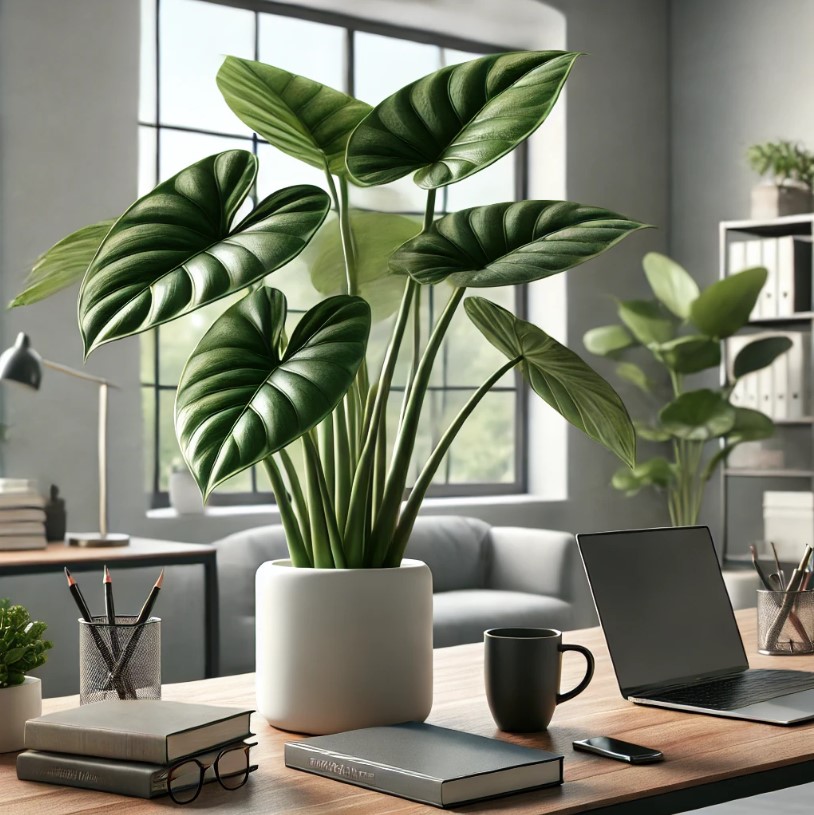
Alocasia plant, commonly referred to as ‘Elephant Ear’ plants, are loved for their bold, tropical leaves and luxurious appeal. But many owners especially face the phenomenon of “Alocasia hair loss” which is the first to lose leaves inexplicably. Leaf Drop May Sound Terrifying, But This Can Often Be Fixed But sometimes it is a normal cycle of the plant. Whether you are a seasoned green thumb or a newbie to houseplants, the possibilities of why Alocasia shed leaves may be overwhelming and lead to confusion; however, this complete guide will not only explore possible reasons why but also some meaningful solutions for health and vitality restoring results.
1. Alocasia Hair Loss: Getting to The Bottom of The Problem
Alocasia hair loss is the leaf falling phenomenon which can be either natural or environmental. Of course, Alocasia do drop older leaves to promote new growth. However, if shedding is excessive, it can be a sign of a problem. You have to know the cause to know how to fix it.
2. Top Reasons for Alocasia Losing Leaves
There are various reasons that can cause drop of Alocasia leaf. They are:
- Overwatering
- Underwatering
- Inadequate lighting
- Temperature fluctuations
- Low humidity
- Pest infestations
- Knowing what these causes are will mean that you can handle the exact needs of your plant.
3. Normal Leaf Dropping or a Leaf Drop Problem?
Unfortunately, not all leaf loss should be treated equally. Older leaves at the bottom of the plant can yellow and fall off naturally as the plant invests energy into new growth. If the loss progresses to many healthy leaves then you need to dig deeper.
4. Too much water: Typical cause of leaf drop
Alocasia hair loss, aka opah, is most commonly caused by overwatering. Signs of overwatering are yellow leaves, saturated soil, and a stench coming from the roots. Root rot occurs as a result, which prevents the plant from taking in nutrients and water.
Solution:
- You can water again after the top 2 inches of soil have dried.
- Provide a breathable soil and pot with holes in drainage.
- In cases of root rot, repot the plant after cutting off the rotting roots
5. So that’s underwatering: crispy, droppy leaves
Inadequate watering takes moisture away from the plant, leading to dry, brown leaves and loss of foliage altogether.
Solution:
- Set up a regular watering schedule.
- • Keep watering until the top 1′ of soil dries out.
- Water it well until water drains from the pot.
6. Light Needs: Finding The Right Middle Ground
The Alocasia loves bright indirect light. Exposure to either too much sun burns the leaves, while too little results in weak growth and dropping foliage.
Solution:
- All you need to do is:
Keep the plant in shadded window. - Turn the plant regularly to give it equal access.
7. Tropical plants need humidity right?
Dropping and curling of leaves in Alocasia is also due to low humidity. As a tropical plant, Alocasia needs high humidity levels to thrive.
Solution:
- Provide high humidity by misting the leaves, having a humidifier running, or using a pebble tray with some water in the vicinity of the plant.
- Arranging plants to create a micro-climate.
8. Temperature Stress and Drafts
They like for temperatures to be consistently between 65°F–80°F (18°C–27°C). Sudden change, drafts, sudden exposure to air conditioning will stress the plant and leave it lose its leaves.
Solution:
- Do not expose the plant to cold drafts nor airflow from fans or vents.
- Do not keep the plant next to heaters such as radiators.
9. The Key to Plant Care: Soil Health
The only thing more critical than this is the type of soil in which the bulbs may grow as bulbs are perennials and waterlogging may cause root rot.
Solution:
- Utilise one part potting soil, one part perlite, and one part peat moss to ensure great drainage
- Don’t plant in compacted soils that hold too much moisture.
10. Alocasia Fertilizer: For Brilliant Growth
Feed your Alocasia a balanced liquid fertilizer every 4-6 weeks during the growing season. If you lavish the plant with too many nutrients it can lead to salt accumulation which discolors and sheds the leaves.
Solution:
- Use fertiliser at half strength.
- Periodically leach the soil to prevent build-up of salts
11. Pruning: Taking Care Of Health And Looks
Trimming dead, damaged, or yellowing leaves allows new growth to receive more energy and flourish.
Solution:
- With clean, sharp scissors, trim leaves at their base.
- Immediately remove any leaf where parasites or disease are present.
12. Addressing Pest Infestations
Common pests such as spider mites, mealybugs, and aphids weaken Alocasia, causing leaves to drop.
Solution:
— Check out the leaves often for proof of pests
Use neem oil, insecticidal soap, or a mild water rinse for control.
13. How To Save An Alocasia That Lost Most Of Its Leaves
You can save your Alocasia too, even if it has lost most of its leaves, if you treat it right!
Steps to Revive:
- Evaluate watering problems and solve them
- Get the plant out and put it into new, quality potting soil.
- Put the plant in a warm humid area in the house but with indirect sunlight.
14. Staving off Future Alocasia Hair Loss
Creating the healthiest plant possible is the ultimate form of prevention.
Tips:
- Keep an eye on moisture and light levels in the soil.
- Keep temperature and humidity at stable levels.
- So check your plant forbugs and deal as great.
15. How to Incorporate Your Alocasia into Your Decor
While you may lose a leaf every now and then, Alocasia is still gorgeous indoor plant to have.
Decorating Ideas:
- You can put this in decorative pot that suit with your interior.
- Place it in bright areas to make it a point of focus.
- Final thoughts: How To Restore And Keep Your Alocasia Looking Good
While Alocasia hair-loss can be quite a challenge, knowing the reasons behind the issue and following appropriate care tips will let you revive your plant back to its original state. So once you have staved off the processes you can enjoy the bright leaves of your Alocasia for many seasons to come by tackling watering, lighting, humidity and pests. Over time, with some tender love and care, this tropical gem will keep growing and beautifying your home indoors.




